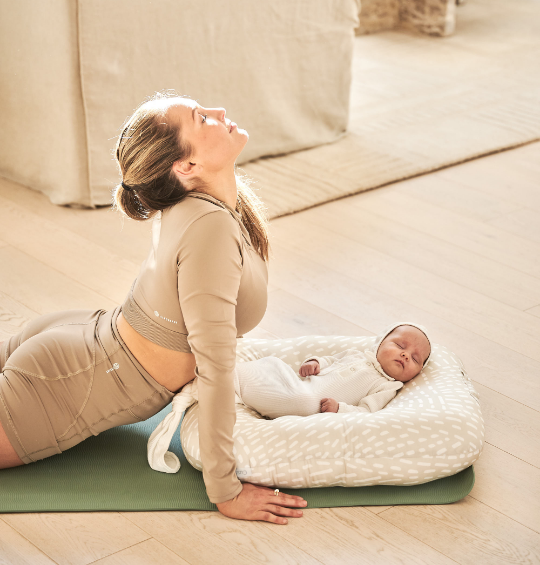
The Ultimate Guide to Postpartum Exercise
Your 12-week postpartum exercise roadmap
It can be tricky to navigate exercise after having a baby.
I’m sure you’ve wondered “When can I start?”, “How do I know if it’s safe?”, “What exercises should I do?”
So many questions and sometimes unclear answers.
We’re taking the confusion out of it for you today and we’ve created the ultimate guide to postpartum exercise.
We invited Stacey McKenzie, a physiotherapist with a special interest in women’s health and founder of Postbump, to share her 12-week postpartum exercise roadmap with the Cushii community.

WEEKS 1-6
For the first 6 weeks you should be focusing on rest, nutrition, light movement and bonding with your baby. Enjoy this special time!
PELVIC FLOOR
You should be able to start your pelvic floor exercises once you leave the hospital. Make sure to stop if you have pain with it or if you think they’re worsening your symptoms and discuss this with your doctor or women’s health physio. Also, please note- do not to do your pelvic floor exercises with a catheter insitu.
How many pelvic floor exercises should you do and how often?
Week 1: 1 sec hold x 10 reps
Week 2: 2 sec hold x 10 reps
Week 3: 3 sec hold x 5 - 10 reps
Week 4: 4 sec hold x 5 - 10 reps
Week 5: 5 sec hold x 5 - 10 reps
Week 6: 6 sec hold x 5 - 10 reps
(3 x a day!)
I would recommend doing your pelvic floor exercises either laying down or sitting to start with. You can progress to standing and doing your pelvic floor exercises functionally as you get better and stronger.
At 6 weeks postpartum I highly recommend seeing a women’s health physio. It’s best if they guide you on your pelvic floor strength and function.
Ab Separation
To manage your ab separation and work on the strength and function of your abs, you should be doing ab exercises.
The progression of your ab exercises can look different depending on your previous fitness, body awareness, ability to contract your abs well, the size and depth of your separation.
While there are some variations it’s best to start with breathing and core activation exercises in your first week postpartum. These can be done laying on your back or on all fours. Breathe in and relax your muscles then breathe out and contract/engage your abs
Once you feel confident you’re activating your core well you can progress to more challenging exercises. Make sure to do ab exercises that are at your level. Doing ab exercises that are too hard for you won’t necessarily be any better for you. The exercises where you’re engaging your core well and creating tension in your linea alba (the connective tissue in the middle of your six pack muscles) are the best ones.
Again, I highly recommend seeing a women’s health physio to help guide you with this.
Exercise
You can usually begin walking in the first week unless a doctor or physio has advised otherwise. I would keep the first walks very short (5 - 10mins) and monitor if you have symptoms during and after. If you do it’s likely a sign you’ve gone too far or done too much.
Once you get comfortable at your current pace and distance you can begin to progress. A general guide is to add about 5 mins extra to your walks each week.
At around 2 - 4 weeks it is usually safe to do light low impact exercises unless your doctor has advised otherwise. Examples include pilates and bodyweight exercises like glute bridges and shallow squats. Again, make sure you’re monitoring for symptoms like leakage or heaviness.
Your women’s health physio will be able to advise you on how to progress your exercises safely.

BONUS TIP
In those early days and weeks I would spend a lot of time laying on your back with your legs up (if it is comfortable) to rest and let gravity do its thing!
If you’re reading this while pregnant I highly recommend you see a women’s health physio so you can learn how to activate your pelvic floor and core and discuss your early postpartum care.
6 – 12 WEEKS
At 6 weeks you should have a check up with your doctor and women’s health physio who will let you know if you are able to start and progress with exercise.
If cleared you should be able to start progressing your cardio and strength exercises. Remember to progress your exercise slowly and continue to monitor your symptoms. Or even better- be guided by your women’s health physio for what exercises you should do and when.
If your goal is to return to high impact exercise like running and jumping it is important that you build your strength first. I recommend adding in single leg exercises like clams and the standing running woman- these will be beneficial for when you eventually start high impact exercise.
Note: Even if you’re cleared for exercise by your doctor at 6 weeks this does not mean you are ready to return to all exercise including high impact exercise. It’s best to have a women’s health physio clear you as well.

12 WEEKS +
Three months postpartum is the earliest that is recommended for returning to high impact exercise like running and jumping. Some may take longer before they are ready and this is often the case.
Your women’s health physio will determine if and when you are ready to return to high impact exercise. There are a few factors that need to be considered:
-
Pelvic floor strength and function
-
Symptom free (eg leakage and heaviness)
-
Body strength
-
Functional testing
Women’s health physio measure these by a subjective examination (talking), an internal examination and functional testing.
The functional test includes movements like forward bounding, squatting and running on the spot. If you have symptoms during the testing it’s a sign you might not be ready for high impact exercise.
Once you are cleared you will begin with single high impact exercises (any movement where you land on one leg). Remember this, like everything else, must progress slowly.
After doing single leg high impact exercises for a while and with no symptoms, you can begin to progress to double leg high impact exercises (eg box jumps, jump squats). These usually create more force on the pelvic floor so they take the longest to return to.

IMPORTANT REMINDER
This is just a very brief and general guide.
It is important that you are cleared by your doctor and women’s health physio and follow their advice when it comes to recovery and exercise postpartum.
Warning signs to look out for while exercising include bladder and bowel leakage, unexplained bleeding, vaginal heaviness, bulging or dragging sensation and musculoskeletal pain.
IT’S GOOD FOR YOU!
While there are timelines to follow, clearances to have and warning signs to look out for- postpartum exercise is good. In fact, it’s great. It is important that you are exercising (the appropriate exercise for you) because it is going to help you be healthy, strong and active to be able to look after you and your baby.
If you want help with returning to exercise after having a baby Postbump offers 1:1 coaching and workout guides
Curious to hear more from Stacey about a supported postpartum journey?
Tune in to The Postbump Podcast on iTunes, Spotify or wherever you listen to your favourite podcasts.
Or follow Stacey on Instagram @

@thedoylediaries




